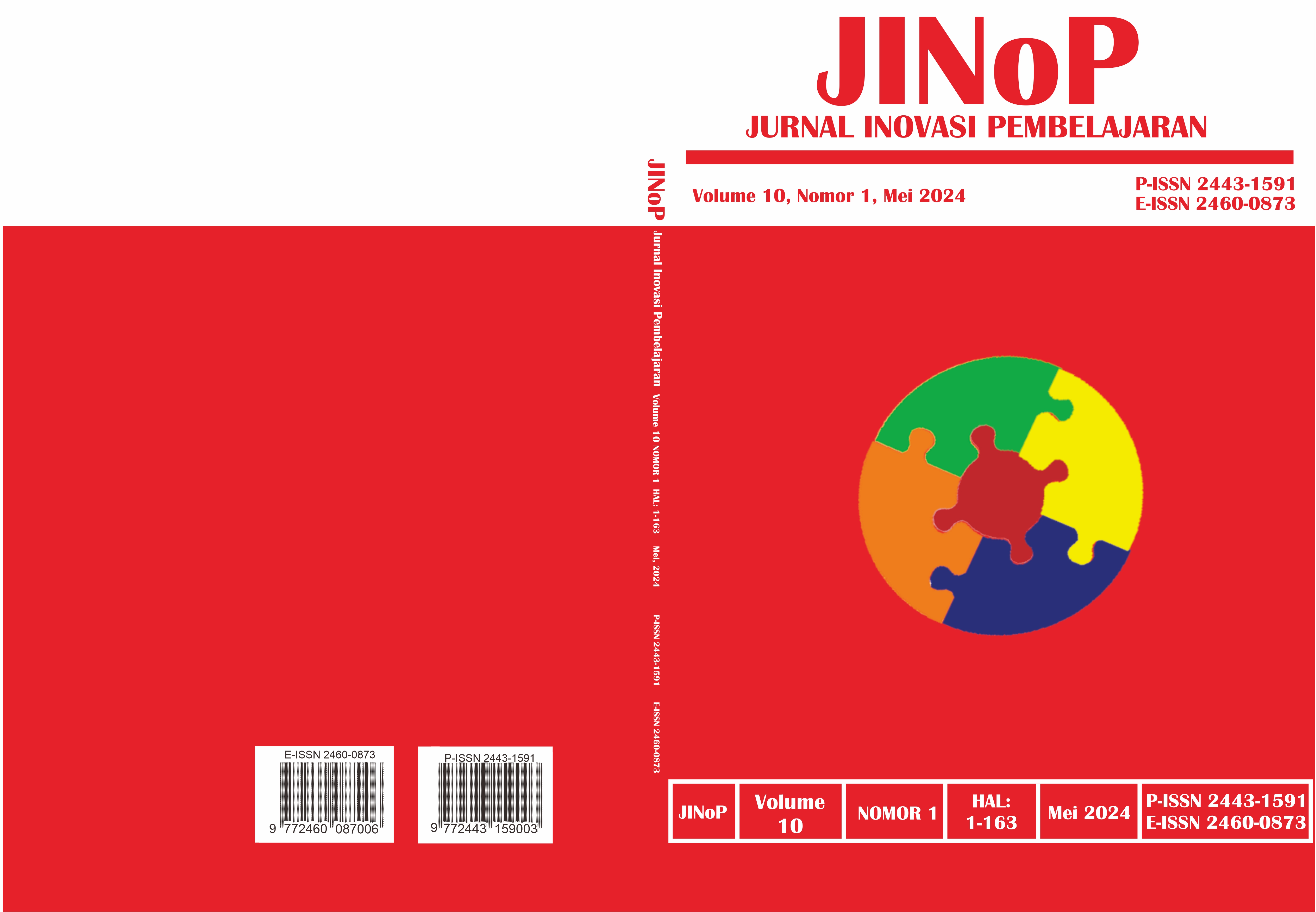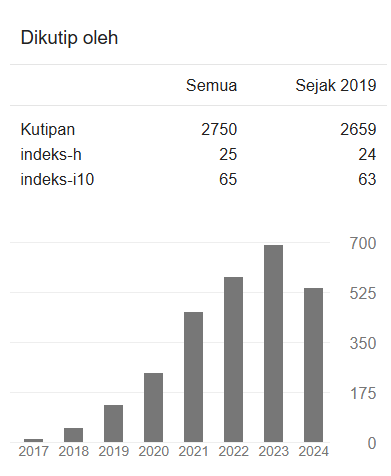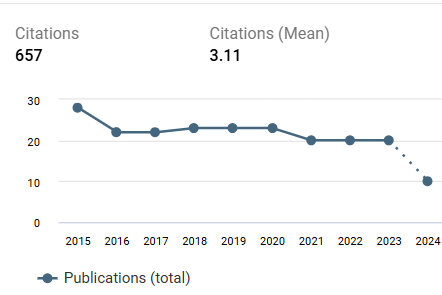Respiratory system pocket book with android-based augmented reality technology
DOI:
https://doi.org/10.22219/jinop.v10i1.22114Keywords:
Augmented Reality, Pocket Book, Respiratory System, AndroidAbstract
Biology is an abstract, elusive science, one of which is respiratory material. It requires a media that can visualize objects on a two-dimensional book of biology to a three-dimensional one with a learning video. Research aims to develop, describe kal, and describe the teacher's assessment and student response to the results of the product developed. This research and development using model 4D consists of define, design, foresight, and develop ate. The result of this realization is the production of a medium of pocket books and apps downloaded on android smartphone platforms, able to present in real, tangible, three-dimensional objects to respiratory matter. The media was declared worthy by the validator of materials and media experts with an average rating score on final validation at 84.68% and 93.17%. Trials in the field as practical tests were obtained an assessment result from teachers by 85.36%, student responses of small groups and large groups are 86% and 83.65%. Also, it is also noted that a media pocket book and applications using this augmented reality technology are worthy to be used by students in studying the human respiratory system for grade 11th MIPA SMAN 1 Kota Jambi.
Downloads
References
Anggereini, E., Budiarti, R. S., & Sanjaya, M. E. (2018). Pengaruh Penerapan Classwide Peer Tutoring (CWPT) Berbasis ICT and Motivasi Terhadap Kreativitas Mahasiswa Pendidikan Biologi dalam Pembelajaran ICT. Biodik : Jurnal Ilmiah Pendidikan Biologi, 4(2), 105–113. https://doi.org/https://doi.org/10.22437/bio.v4i2.6177
Arif, M. H., & Rukmi, A. S. (2020). Pengembangan Buku Suplemen untuk Keterampilan Menulis Deskripsi Siswa Kelas IV Sekolah Dasar. Jurnal Penelitian Pendidikan Sekolah Dasar, 8(5), 1033–1043. Retrieved from https://ejournal.unesa.ac.id/index.php/jurnal-penelitian-pgsd/article/view/36680
Bakhruddin, M., Shoffa, S., Holisin, I., Ginting, S., Fitri, A., Widya, I. L., Pudyastuti, Z. E., Zainuddin, M., Alam, H. V., & Kurniawati, N. (2021). Strategi Belajar Mengajar ‘Konsep Dasar and Implementasinya’. Jawa Timur: CV. Agrapana Media.
Buchner, J., & Hofmann, M. (2022). The More the Better ? Comparing Two SQD ‑ Based Learning Designs in a Teacher Training on Augmented and Virtual Reality. International Journal of Educational Technology in Higher Education, 19(24), 1–17. https://doi.org/10.1186/s41239-022-00329-7
Daeng, I. T. M., Mewengkang, N. N., & Kalesaran, E. R. (2017). Penggunaan Smartphone Dalam Menunjang Aktivitas Perkuliahan Oleh Mahasiswa Fispol Unsrat Manado. Acta Diurna, 6(1), 1–15. Retrieved from https://ejournal.unsrat.ac.id/index.php/actadiurnakomunikasi/article/view/15482
Dewi, D. A. S., Putra, I. K. G. D., & Bayupati, I. P. A. (2017). Aplikasi Augmented Reality Jurusan Teknologi Informasi Universitas Udayana (AR-TI). Jurnal Ilmiah Merpati (Menara Penelitian Akademika Teknologi Informasi), 5(1), 9–16.
Dutta, R., Mantri, A., & Singh, G. (2022). Evaluating System Usability of Mobile Augmented Reality Application for Teaching Karnaugh ‑ Maps. Smart Learning Environments, 9(6), 1–27. https://doi.org/10.1186/s40561-022-00189-8
Faisal, A. H., Zuriyati, & Leiliyanti, E. (2019). Persepsi Siswa and Guru Terhadap Pengembangan Multimedia Berbasis Aplikasi Android. Jurnal KIBASP (Kajian Bahasa, Sastra And Pengajaran), 3(1), 170–178. https://doi.org/https://doi.org/10.31539/kibasp.v3i1.94
Famukhit, M. L. (2018). Analisis Perbandingan Media Marker Augmented Reality Menggunakan Software Unity 3D. Jurnal Penelitian Pendidikan, 10(2), 1526–1532. Retrieved from https://ejournal.stkippacitan.ac.id/ojs3/index.php/jpp/article/view/202
Gumilar, S. I., & Aulia, F. T. (2021). Cerdas Cergas Berbahasa dan Bersastra Indonesia. Jakarta: Pusat Kurikulum dan Perbukuan Badan Penelitian dan Pengembangan dan Perbukuan Kementerian Pendidikan, Kebudayaan, Riset, dan Teknologi.
Hawari, N. A., & Putra, E. D. (2022). Analisis Perbandingan Metode Multimedia Development Live Cycle pada Augmented Reality. Jurnal Media Infotama, 18(1), 48–55. https://doi.org/https://doi.org/10.37676/jmi.v18i1.1759
Hutami, A., Azizah, A., & Norlita. (2023). Kecanggihan Smartphone sebagai Media Pembelajaran Di Era Modern. Borneo Journal of Islamic Education, 3(1), 65–73. https://doi.org/https://doi.org/10.21093/bjie.v3i1.6333
Ihsan, Yaqutunnafis, L., & Salkiah, B. (2023). Pengembangan Video Tutorial Sebagai Media Pembelajaran Analisis Regresi Pada Perkuliahan Ekonometrika. JPEK (Jurnal Pendidikan Ekonomi dan Kewirausahaan), 7(2), 524–531. https://doi.org/https://doi.org/10.29408/jpek.v7i2.23526
Ikbal, M., Alberida, H., & Ahda, Y. (2021). Pengembangan Media Pembelajaran Berbasis Android pada Materi Transkripsi and Translasi untuk Mata Kuliah Genetika The Development of Android-Based Learning Media in Transcription and Translation Material for Genetic Courses. BiosciED: Journal of Biological Science and Education, 2(1), 36–46. https://doi.org/https://doi.org/10.37304/bed.v2i1.2739
Indrawan, I. W. A., Saputra, K. O., & Linawati, L. (2021). Augmented Reality sebagai Media Pendidikan Interaktif dalam Pandemi Covid-19. Majalah Ilmiah Teknologi Elektro, 20(1), 61–70. https://doi.org/https://doi.org/10.24843/MITE.2021.v20i01.P07
Indrayani, I. G. A. P. U., Astawan, I. G., & Sumantri, M. (2021). Media Pembelajaran Audio Visual Berorientasi Nilai Karakter pada Materi Siklus Air. MIMBAR PGSD Undiksha, 9(2), 238–247. https://doi.org/https://doi.org/10.23887/jjpgsd.v9i2.36199
Indriyani, R., Waluyo, J., & Prihatin, J. (2016). Validitas Perangkat Pembelajaran IPA Model Inkuiri Terbimbing untuk Melatihkan Keterampilan Pemecahan Masalah Siswa SMP Materi Pencemaran Lingkungan. Jurnal Pembelaajran And Pendidikan Sains, 1(1), 77–85. Retrieved from https://jurnal.unej.ac.id/index.php/jpps/article/view/4669
Indriyani, W. T., Muswita, & Sanjaya, M. E. (2022). Pengembangan E-kamus Biologi Materi Klasifikasi Tumbuhan Dicotyledoneae Pada Kelas X SMA Negeri 4 Muaro Jambi. Biodik : Jurnal Ilmiah Pendidikan Biologi, 08(02), 62–72. https://doi.org/https://doi.org/10.22437/bio.v8i2.17809
Ismayani, A. (2020). Membuat Sendiri Aplikasi Augmneted Reality. Jakarta: PT Elex Media Komputino.
Kemendikbud. (2020). Rencana Strategis Kementrian Pendidikan and Kebudayaan 2020-2024. Jakarta: Kemendikbud.
Kurniawati, F. N. A. (2022). Meninjau Permasalahan Rendahnya Kualitas Pendidikan di Indonesia and Solusi. AoEJ: Academy of Education Journal, 13(1), 1–13. https://doi.org/https://doi.org/10.47200/aoej.v13i1.765
Liao, T. (2019). Future Directions for Mobile Augmented Reality Research : Understanding Relationships Between Augmented Reality Users , Nonusers , Content , Devices , and Industry. Mobile Media & Communication, 7(1), 131–149. https://doi.org/https://doi.org/10.1177/2050157918792
Maknuni, J. (2020). Pengaruh Media Belajar Smartphone Terhadap Belajar Siswa Di Era Pandemi Covid-19. Indonesian Education Administration and Leadership Journal (IDEAL), 02(02), 94–106. Retrieved from https://online-journal.unja.ac.id/IDEAL/article/view/10465
Mashuri, D. K., & Budiyono. (2020). Pengembangan Media Pembelajaran Video Animasi Materi Volume Bangun Ruang untuk SD Kelas V. Jurnal Penelitian Pendidikan Guru Sekolah Dasar, 8(5), 893–903. Retrieved from https://ejournal.unesa.ac.id/index.php/jurnal-penelitian-pgsd/article/view/35876
Mawaddah, W., Ahied, M., Hadi, W. P., Retno, A. Y., & Wulandari. (2019). Uji Kelayakan Multimedia Interaktif Berbasis Powerpoint Disertai Permainan Jeopardy Terhadap Motivasi Belajar Siswa. Natural Science Education Research, 2(2), 174–185. https://doi.org/10.21107/nser.v2i2.6254
Mokalu, V. R., Panjaitan, J. K., Boiliu, N. I., & Rantung, D. A. (2022). Hubungan Teori Belajar and Teknologi Pendidikan. Edukatif : Jurnal Ilmu Pendidikan, 4(1), 1475–1486. https://doi.org/10.31004/edukatif.v4i1.2192
Nawir, F., & Hamdat, A. (2021). Penerapan Augmented Reality Sebagai Media Digital Marketing Di Masa Pandemi Covid 19 Pada Pengusaha Penginapan Di Malino. TEKMULOGI:Jurnal Pengabdian Masyarakat, 1(1), 41–46. https://doi.org/10.17509/tmg.v1i1.34299
Nento, F., & Manto, R. (2023). Peran Teknologi dalam Dunia Pendidikan. E-TECH:Jurnal Ilmiah Teknologi Pendidikan, 11(01), 1–5. Retrieved from https://ejournal.unp.ac.id/index.php/e-tech/article/view/123814/0
Panggabean, N. H., & Andis, A. (2020). Desain Pengembangan Bahan Ajar Berbasis Sains. Batusangkar: Yayasan Kita Menulis.
Pauziah, D., & Laksanawati, W. D. (2023). Pengembangan Media Pembelajaran Fisika Berbasis Augmented Reality Pada Materi Struktur Kristal. Jurnal Penelitian Pembelajaran Fisika, 14(2), 179–188. https://doi.org/https://doi.org/10.26877/jp2f.v14i2.15763
Perwitasari, I. D. (2018). Teknik Marker Based Tracking Augmented Reality untuk Visualisasi Anatomi Organ Tubuh Manusia Berbasis Android. INTECOMS: Journal of Information Technology and Computer Science, 1(1), 2614–1574. https://doi.org/10.31539/intecoms.v1i1.161
Putri, D. A., & Arifitama, B. (2020). Penerapan Augmented Reality Untuk Materi Penggolongan Hewan Berdasarkan Jenis Makanan. Seminar Nasional Mahasiswa Ilmu Komputer And Aplikasinya (SENAMIKA), 58–64. Jakarta. Retrieved from https://conference.upnvj.ac.id/index.php/senamika/article/view/309
Rafael, A. M. D., & Enstein, J. (2022). Pemanfaatan Google Jamboard Sebagai Media Pembelajaran Bahasa Di Kelas Rendah Sekolah Dasar. Jurnal Pendidikan Teknologi Informasi (JUKANTI), 5(1), 2621–1467. https://doi.org/https://ojs.cbn.ac.id/index.php/jukanti/article/view/483
Raida, S. A. (2018). Identifikasi Materi Biologi SMA Sulit Menurut Panandgan Siswa and Guru SMA Se-Kota Salatiga. Journal Of Biology Education, 1(2), 209–222. http://dx.doi.org/10.21043/jobe.v1i2.4118
Riyanto, S., & Hatmawan, A. A. (2020). Metode Riset Penelitian Kuantitatif Penelitian di Biandg Manajemen, Teknik, Pendidikan and Eksperimen. Yogyakarta: Deepublish.
Rohmani, Apriza, B., & Mahendra, Y. (2021). Pengembangan Gim Kuis Edukasi Suplemen Buku Ajar Pengantar Dasar IPA Berbasis Website. JINoP ( Jurnal Inovasi Pembelajaran ), 7(2), 194–208. https://doi.org/10.22219/jinop.v7i2.18576
Salsabila, U. H., Amalia Putri, V., Cahyani, P., Tri Yuliatin, A., & Ahmad Dahlan, U. (2021). Upaya Dalam Memajukan Teknologi Pendidikan Indonesia. NUSANTARA : Jurnal Pendidikan dan Ilmu Sosial, 3(3), 442–458. https://ejournal.stitpn.ac.id/index.php/nusantara
Sari, A. W., Rostikawati, T., & Sari, R. P. (2023). Pengembangan Video Pembelajaran Interaktif Berbasis Augmented Reality pada pembelajaran Satu Subtema Keteraturan yang Menakjubkan. Didaktik:Jurnal Ilmiah PGSD FKIP Universitas Mandiri, 09(04), 551–561. https://doi.org/10.36989/didaktik.v9i04.1606
Shakeel, S. R., Shahbaz, U., & Khan, D. S. (2019). Augmented Reality. Advances in Social Sciences Research Journal, 6(7), 416–423. https://doi.org/10.14738/assrj.67.6856
Sofyan, A., & Hidayat, A. (2022). Motivasi Belajar Mahasiswa Teknologi Pendidikan dalam Pembelajaran Online. Jurnal Satya Informatika, 7(2), 16–25. https://doi.org/10.17977/um038v4i12021p090
Sohilait, E. (2020). Metodologi Penelitian Matematika. Bandung: CV. Cakra.
Sugeng, B. (2022). Fundamental Metodologi Penelitian Kuantitatif (Eksplanatif). Deepublish.
Sugiyono. (2013). Metode Penelitian Kuantitatif, Kualitatif, dan R&D (Cet.19). Bandung: Alfabeta.
Suryadi, C. B., & Sofya, R. (2023). Pengembangan Video Pembelajaran Ekonomi dengan Aplikasi Kinemaster Pada Pembelajaran Ekonomi. Jurnal Ecogen, 6(3), 412–421. https://ejournal.unp.ac.id/students/index.php/pek/article/view/15039
Tumini, & Romadhon, A. F. (2022). Implementasi Augmented Reality Untuk Pengenalan Kata Benda Berbahasa Arab ( Mufrodat ) Di TPQ An-Nahdliyah At-Taqwa. Jurnal Informatics and Digital Expert (INDEX), 3(2), 46–54. https://doi.org/10.36423/index.v3i2.760
Turhusna, D., & Solatun, S. (2020). Perbedaan Individu dalam Proses Pembelajaran. As-Sabiqun-:Jurnal Pendidikan Islam Anak Usia Dini, 2(1), 28–42. https://doi.org/10.36088/assabiqun.v2i1.613
Ulfa, A. M., Siburian, J., & Kartika, W. D. (2022). Analisis Kelayakan Panduan Praktikum Perkembangan Hewan Berbasis Inkuiri pada Materi Siklus Estrus. Edukatif : Jurnal Ilmu Pendidikan Vol, 4(2), 2338–2344 https://edukatif.org/index.php/edukatif/article/view/2350
Wahyuningtyas, N., & Yahya, M. H. (2021). Pengembangan Aplikasi ‘SIMBA’ (Social Studies Instructional Media Based Android) untuk Mata Pelajaran IPS kelas VII SMP. JINoP (Jurnal Inovasi Pembelajaran), 7(2), 153–166. https://doi.org/10.22219/jinop.v7i2.15918
Wati, N. T., Erviyenni, & Holiwarni, B. (2019). Pengembangan Bahan Ajar dalam Bentuk Buku Saku pada Pokok Bahasan Asam Basa. Jurnal Pendidikan Kimia Universitas Riau, 4(2), 36–46. https://doi.org/://dx.doi.org/10.33578/jpk-unri.v4i2.7165
Zaki, M. A., Hakro, D. N., Memon, M., Zaki, U., & Hameed, M. (2019). Internet Of Things Interface Using Augmented Reality : An Interaction Paradigm using Augmented Reality. University of Sindh Journal of Information and Communication Technology (USJICT), 3(3), 135–140. https://sujo.usindh.edu.pk/index.php/USJICT/article/view/602
Downloads
Published
How to Cite
Issue
Section
License
Copyright (c) 2024 Siburian et al

This work is licensed under a Creative Commons Attribution 4.0 International License.
Copyright Notice
Authors who publish with JINoP (Jurnal Inoasi Pembelajaran) agree to the following terms:
- For all articles published in the JINoP (Jurnal Inovasi Pembelajaran), copyright is retained by the authors. Authors give permission to the publisher to announce the work with conditions. When the manuscript is accepted for publication, the authors agree to the automatic transfer of the publishing right to the publisher.
- Authors retain copyright and grant the journal the right of first publication with the work simultaneously licensed under a Creative Commons Attribution 4.0 International License. that allows others to share the work with an acknowledgment of the work's authorship and initial publication in this journal.
- Authors are able to enter into separate, additional contractual arrangements for the non-exclusive distribution of the journal's published version of the work (e.g., post it to an institutional repository or publish it in a book), with an acknowledgment of its initial publication in this journal.
- Authors are permitted and encouraged to post their work online (e.g., in institutional repositories or on their website) prior to and during the submission process, as it can lead to productive exchanges, as well as earlier and greater citation of published work (See The Effect of Open Access).








